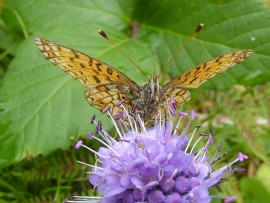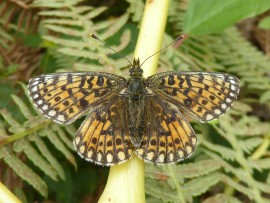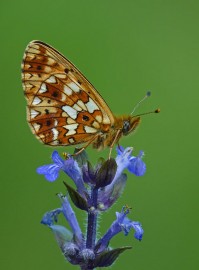by Martin Kalaher
There was a dreadful late spring/early summer in 2012, when it rained for most of April, May and June - or so it seemed at the time. If that wasn't bad enough, the following spring in 2013 was the coldest for 50 years. In 2013 the usual emergence date of May 24th came and went but it wasn't until three weeks later, on a bright sunny day, that four adults emerged on June 14th. Just one nice day and the weather deteriorated once again and over the next couple of weeks there was only the occasional sighting with the last record on June 29th. In the following year no adults were seen, and this attractive fritillary ceased to be a breeding species in Sussex. Despite the herculean efforts of so many BC volunteers over many, many years the small relic population that had "held on" in Park Corner Heath/Rowland Wood, was no more. How did this sad state of affairs come to pass?
For modern entomologists it is hard to believe that this was once a common butterfly species in Sussex. Colin Pratt in his 2011 county history reminds us that for the 100 years or more leading up to the mid-1970s some 150 colonies had been discovered within Sussex. Even during the previous atlas survey period of 1990-1994 Small Pearl-bordered Fritillaries were found in 24 tetrads, although the western vice-county was limited to just four tetrads (and so "the writing was on the wall"). So, why did this species undergo such a cataclysmic decline?
As with all butterfly species, a sound understanding of its breeding requirements helps us appreciate why a species might struggle. This species has been very badly affected by changes in woodland management that has evolved from the 1950s, onwards. The steep decline and then nigh-on cessation of coppicing, together with our collective dalliance with exotic conifers had a catastrophic effect on suitable habitat. Unlike its larger cousin the Pearl-bordered Fritillary which requires violet seedlings and first year plants, this species is dependent on lush clumps of violets which may be found 3-4 years after an area of woodland has been cleared. Otherwise, these clumps may be located on the banks of wet ditches where the soil is crumbly, and where violets may compete and not become swamped by grass species. Add to these requirements the need for sun-exposed areas or at least dappled-shade and it is apparent that most of our dark, dank woods do not pass muster. If one looks at the national situation, this species continues to thrive on the western side of the mainland, ironically where the rainfall is high and where most butterfly species find it difficult to cope. It is not that this species is partial to rain, far from it, but the violets on which it depends, do like it nice and damp!
In its later years in Sussex, this species flew in a single brood from mid-May until the end of June. The males behave similarly to Pearl-bordered Fritillaries, skimming across their breeding sites in their ceaseless search for females. After mating the females hide until their eggs are ripe and then flutter slowly across the ground in search of violets. Common Dog-violet is the most abundant violet in most Sussex woodlands but elsewhere in wetter areas it is the Marsh Violet which is chosen. Eggs are generally laid on medium-size plants grown in open, sunny localities. The caterpillar hatches after a couple of weeks and begins to feed on lush violet leaves. It moults three times, before hibernating in leaf or bracken litter. In the following spring it resumes feeding and then moults for a fourth and last time before forming a chrysalis which is suspended from low-growing plants or bracken debris. This pupal stage lasts for 2-3 weeks, after which the adult butterfly emerges.
The main confusion species is the Pearl-bordered Fritillary. Both the Pearl-bordered and Small Pearl-bordered Fritillary have seven silver "pearls" along the borders of each lower underwing. The former has just two bright patches of silver on either side of a central pentagonal cell that houses a black dot, whilst the latter has a larger black spot in this cell, which is surrounded by seven or eight patches of silver.
Having lost this species in 2013, is there a future in Sussex for this delightful fritillary? For it to return to the glory days of the past we would have to re-produce "the past", and have very extensive areas of coppiced woodland. Well, wouldn't that be nice, but it probably won't happen. However, with a highly-focussed conservation effort this species could become re-established in Park Corner Heath/Rowland Wood and thereafter spread into that area which is now known as Vert Woods Community Woods. As Neil Hulme writes in "The Butterflies of Sussex": "Butterfly Conservation's Fritillaries for the Future project was launched in 2015, with one of its aims being to assess the viability of re-instating this species to South East England". Thanks to Mike Mullis and ably assisted by volunteers Theresa Lux and Gary Norman a re-introduction programme began in 2017. As the saying goes, "watch this space".
Finally, a special mention to some of the people involved in the Park Corner Heath/Rowlands Wood reserve. In date order: Reserve managers, John Hicks (1990-1994), Roger Carter (1994-1996), Graham Parris (1997-2007), Michael Blencoe (2007-2010) and Bob Foreman (2010 - present). Also, the enormous number of members who have willingly given their time and energy in this "cause celebre", including David Mitchell, who was always present when something needed doing.





-2760971984.jpg)
-6856888080.jpg)
-7096515554.jpg)

